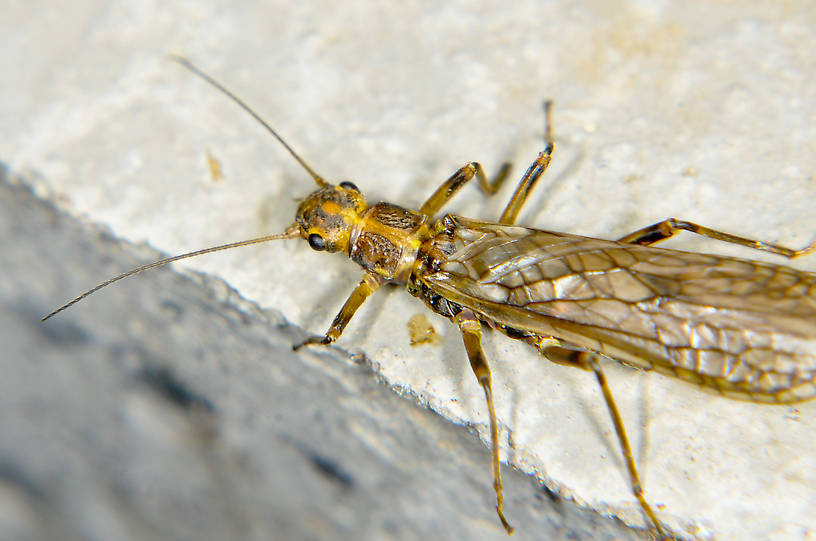
Blue-winged Olives
Baetis
Tiny Baetis mayflies are perhaps the most commonly encountered and imitated by anglers on all American trout streams due to their great abundance, widespread distribution, and trout-friendly emergence habits.


Stonefly Species Megarcys subtruncata (Springflies)
Species Range
Physical description
Most physical descriptions on Troutnut are direct or slightly edited quotes from the original scientific sources describing or updating the species, although there may be errors in copying them to this website. Such descriptions aren't always definitive, because species often turn out to be more variable than the original describers observed. In some cases, only a single specimen was described! However, they are useful starting points.
Description from GBIFthe Global Biodiversity Information Facility
Source: Larvae Of The Nearctic Species Of The Stonefly Genus Megarcys Klapálek (Plecoptera: Perlodidae)
(Figs. 14 - 16, 20, 22, 26 - 28, 32 - 34, 38 - 40, 44 - 46, 51, 52, 62 - 64, 72, 81, 86, Table 1)Source: Larvae Of The Nearctic Species Of The Stonefly Genus Megarcys Klapálek (Plecoptera: Perlodidae)
Characters. Butte Creek, California, macropterous population: Head capsule width male 3.78 - 3.90 mm, female 4.68 - 4.74 mm; pronotal width male 3.36 - 4.48 mm, female 4.20 mm; body length male 17.9 - 21.6 mm, female 22.2 - 25.5 mm (Table 1). Color and pigmentation (Figs. 15, 27, 33, 39, 45, 51), lacinia (like Ohanapecosh River, Washington population Fig. 28), and dorsomesal band of erect silky white hairs typical of genus. Wing pads of male (Fig. 27) and female macropterous. Gill number and arrangement typical of genus (Fig. 62). Submental gill length male 0.39 - 0.54 mm, female 0.54 - 0.66 mm; anterior supracoxal gill length male 0.42 - 0.54 mm, female 0.54 - 0.66 mm (Table 1). Legs (Fig. 33) with typical setation of genus as described by Stewart & Stark (2002). Y-arms of mesosternum (Fig. 39) typical of genus. Cercal segments male 24 - 26 (Table 1), with setation typical of genus. Developing membranous windsock-like process of male epiproct (Fig. 72) evident in late instar individuals, and pointed posteroventrally in lateral view (Fig. 81). Developing female subgenital plate of 8 th sternum (Figs. 51, 86) shallowly notched mesally.
Quinn Spring, Oregon, brachypterous population: As indicated by Stark & Baumann (2005), larvae of this population, that they did not describe in detail, “ agree in most respects ” with the generic description in Stewart & Stark (2002). Head capsule width male 3.12 - 3.48 mm, female 4.20 - 4.22 mm; pronotal width male 2.94 - 3.12 mm, female 4.02 - 4.26 mm; body length male 15.6 - 16.0 mm, female 19.5 - 21.2 mm. Color and pigmentation (Figs. 16, 28, 34, 40, 46), lacinia typical of genus. Dorsomesal band of erect silky white hairs and those along the ecdysial suture of the head absent. Wing pads male (Fig. 28) and female brachypterous. Gill number and arrangement typical of genus. Submental gill (Fig. 63) length male 0.27 - 0.30 mm, female (Fig. 64) 0.34 - 0.36 mm; anterior supracoxal gill length male 0.21 - 0.24 mm, female 0.30 - 0.34 mm (Table 1). Legs (Fig. 34) with typical setation of genus. Y-arms of mesosternum (Fig. 40) typical of genus. Cercal segments of male 22 + (all broken), dorsal silky fringe (typical of the other four species) absent or with a few obscure setae on basal segments. Developing membranous, windsock-like process of male epiproct evident in late instar individuals, and pointed posteroventrally in lateral view like the Butte Creek, California, population (Fig. 81). Developing female subgenital plate of 8 th sternum shallowly notched mesally like the Butte Creek, California, population (Figs. 51, 86).
Specimens of the Stonefly Species Megarcys subtruncata
1 Adult
Start a Discussion of Megarcys subtruncata
Stonefly Species Megarcys subtruncata (Springflies)
Species Range
Common Names
Resources
- NatureServe
- Integrated Taxonomic Information System
- Global Biodiversity Information Facility
- Described by Hanson, J.F. (1942) Records and descriptions of North American Plecoptera. Part II. Notes on North American Perlodidae. The American Midland Naturalist 28, 389–407.


